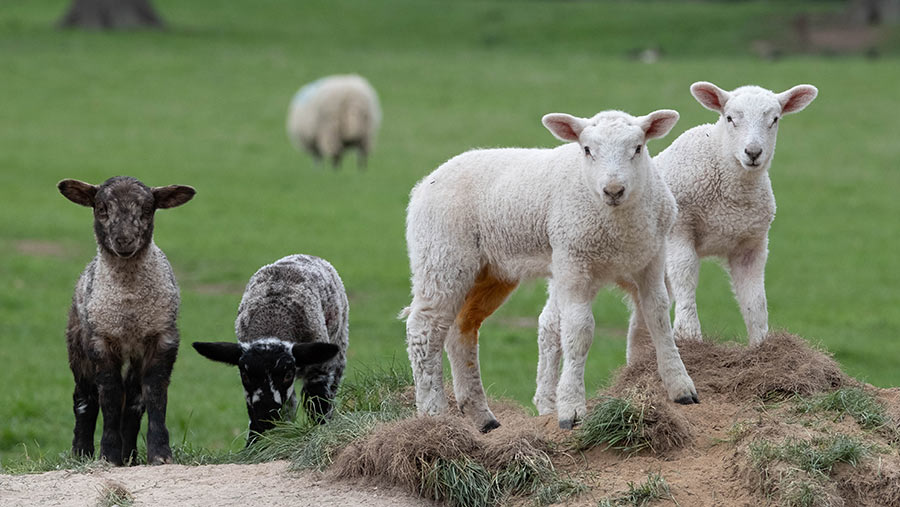Coccidiosis project raises hope for new treatment
 © Tim Scrivener
© Tim Scrivener Coccidiosis is a perennial parasitic problem in growing lambs. It presents some difficulties in diagnosis, treatment and prevention – but good news could be around the corner.
Lambs and calves surviving a bout of coccidiosis are very strongly immune afterwards, and do not become ill if challenged with the same species.
This means there could be scope to develop vaccines. These would be given before lambs and calves meet the coccidial parasites.
See also: Q&A: How to prevent and treat coccidiosis in calves
How vaccines could help
Vaccines would reduce the amount of damage caused, as the immunity effectively bounces, or repels, the parasites off the lining of the gut.
There is good experimental work showing that exposing very young lambs (one to five days old) to coccidial parasites makes them much more resistant to later challenge.
In addition, live attenuated vaccines for coccidiosis are used commercially in poultry production.
There have been many recent advances in vaccine technology. Specific parts of the organism can be targeted, rather like the spike protein targeted in the recent successful Covid vaccination programme.
How farmers can help
Farm Post Mortems is working on a project with the AHDB and Biotechnology and Biological Sciences Research Council (BBSRC). This aims to identify the parts of the coccidial parasites that might make good targets for vaccines.
We are looking for faecal samples (and carcasses if affected animals die) from any cases of coccidiosis in lambs and calves.
These samples will be used to figure out the genetic code and identify genes and proteins in the coccidia, which are important in helping the parasite to get into the gut.
If the immune system can recognise these targets before lambs become infected, we hope that infections will be much less severe.
If you have had an outbreak of coccidiosis confirmed by your vet and would like to help contribute to this project, please get in contact at ben@farmpostmortems.co.uk or 07899 950 372.
Tips for managing coccidiosis now
- Watch lambs carefully and collect faecal samples from any with bloody scour
- Treat lambs promptly with a coccidiostat if coccidiosis is diagnosed
- Submit any dead lambs for post-mortem examination to enable prompt diagnosis
- Try to group lambs of similar age together and minimise the age spread within any group
- Avoid accumulation of dung around high-traffic areas such as creep feeders and under trees
- Be sure not to mistake coccidiosis for nematodirosis. Generally, lambs are affected by coccidiosis at a younger age than nematodirus, but this depends on location and season
Coccidiosis Q&A
What is coccidiosis?
Coccidiosis, or cocci for short, is caused by small protozoan parasites (Eimeria species) that live in the large and small intestines, and damage it.
The coccidial parasites exist in very small numbers in the guts of ewes and cows during the winter.
The first few lambs born will consume small numbers of these parasites and multiply them up quickly in their guts.
They then pass out much larger numbers of parasites, which younger animals can eat, leading to severe damage and death.
This snowball effect is difficult to predict and treat in lambs because not all lambs are affected at the same time.
When does it occur?
- In lambs: At three to eight weeks of age. In March-lambing flocks, cocci will typically be seen in April; in April-lambing flocks, it will commonly appear in May. Second waves of lambs tend to be hit as the parasites have had time to accumulate.
- In suckler calves: There are two periods. The first is the housing period at three to 10 weeks old. Clean bedding helps minimise the risk to these calves. The second occurs at grass when the calves are six to 10 weeks old.
- In dairy calves: Rearing calves can be affected all year if stocking densities are too high and there is an environmental build-up of parasites.
How does it affect animals?
Animals generally look poor. They have scours, which may be bloody, and have a much-reduced daily liveweight gain. They have dull, starry coats (hair/wool is patchy and stands on end).
Is there transfer between species?
Cattle coccidia cannot infect lambs and vice versa. Birds cannot infect lambs or calves – this is a myth.
The different strains of coccidia only infect one species and do not transfer between different species.
Current treatment
Currently, the most common treatment is to give lambs an oral dose of a coccidiostat containing diclazuril or toltrazuril.
This stops the coccidial parasites multiplying in the guts and allows the lamb to recover. However, these treatments are only effective when the parasites are actually in the gut, and they are not very persistent.
That means that in a field of lambs, there will three different groups:
- Lambs that have not had the parasite yet. It is a waste of money to treat these as there is no parasite in them for the drug to work on
- Lambs that have coccidiosis at the correct stage of development for the treatment to be effective
- Lambs that have had coccidiosis and recovered. They may have poorer growth rates but are no longer infected, so again, there are no parasites for the drug to work on.
How many of each type of lamb you have at any moment is difficult to say. It’s a good idea to take faecal samples to assess parasite burdens.
However, in practice, treatment is often based on suspicion. This probably means some lambs are treated that don’t need treating. However, this is generally seen as an acceptable compromise for the greater good.

